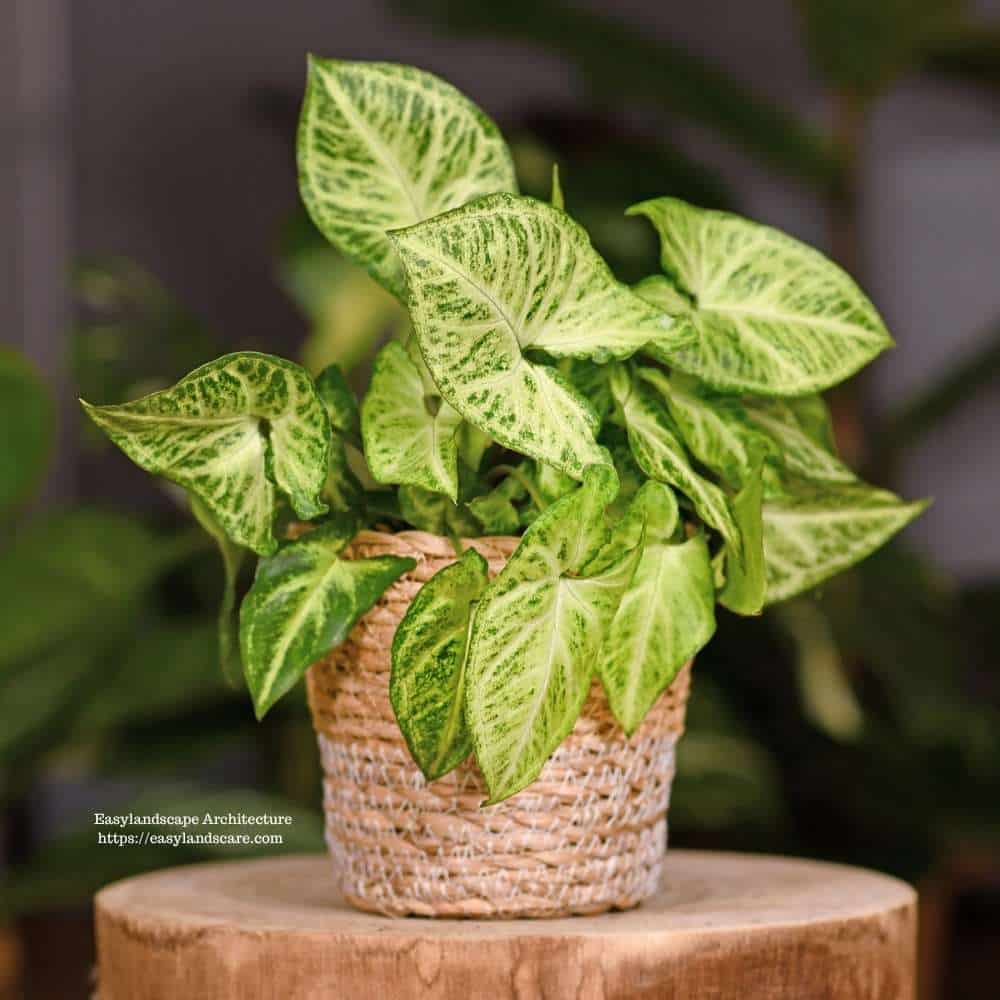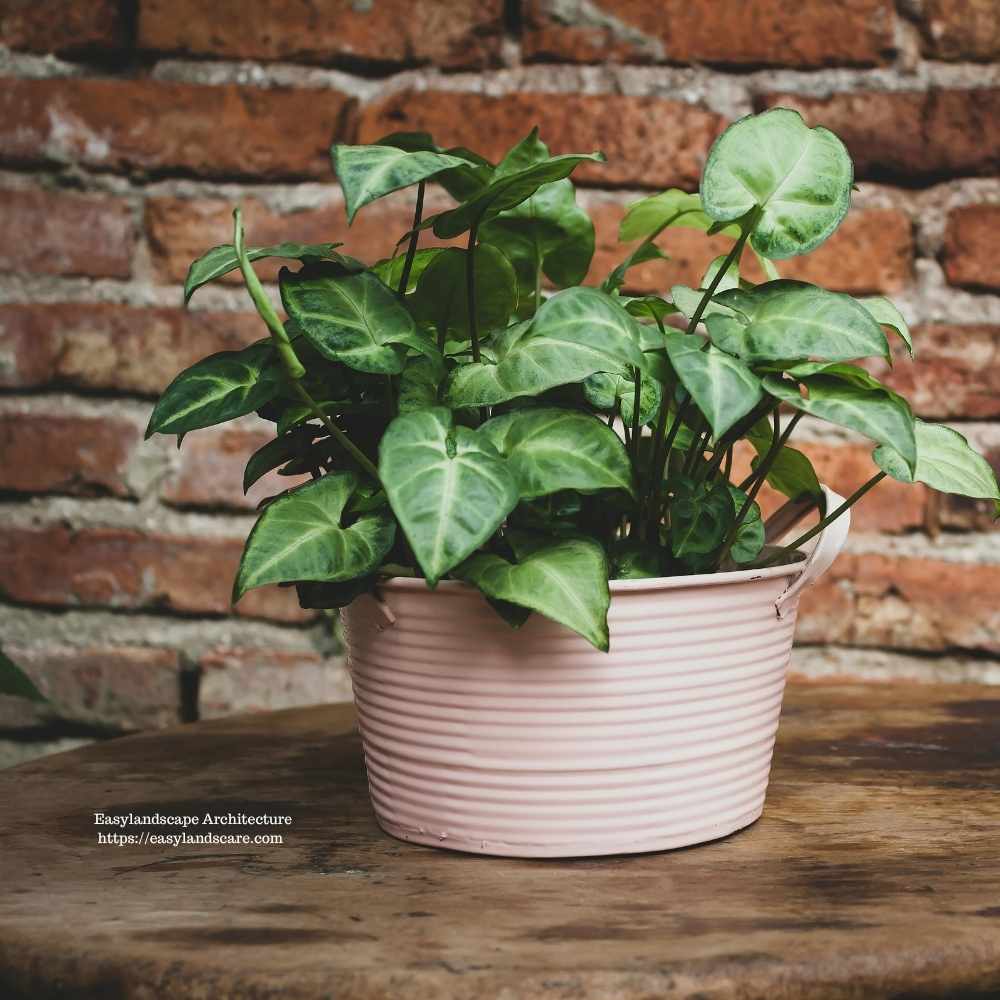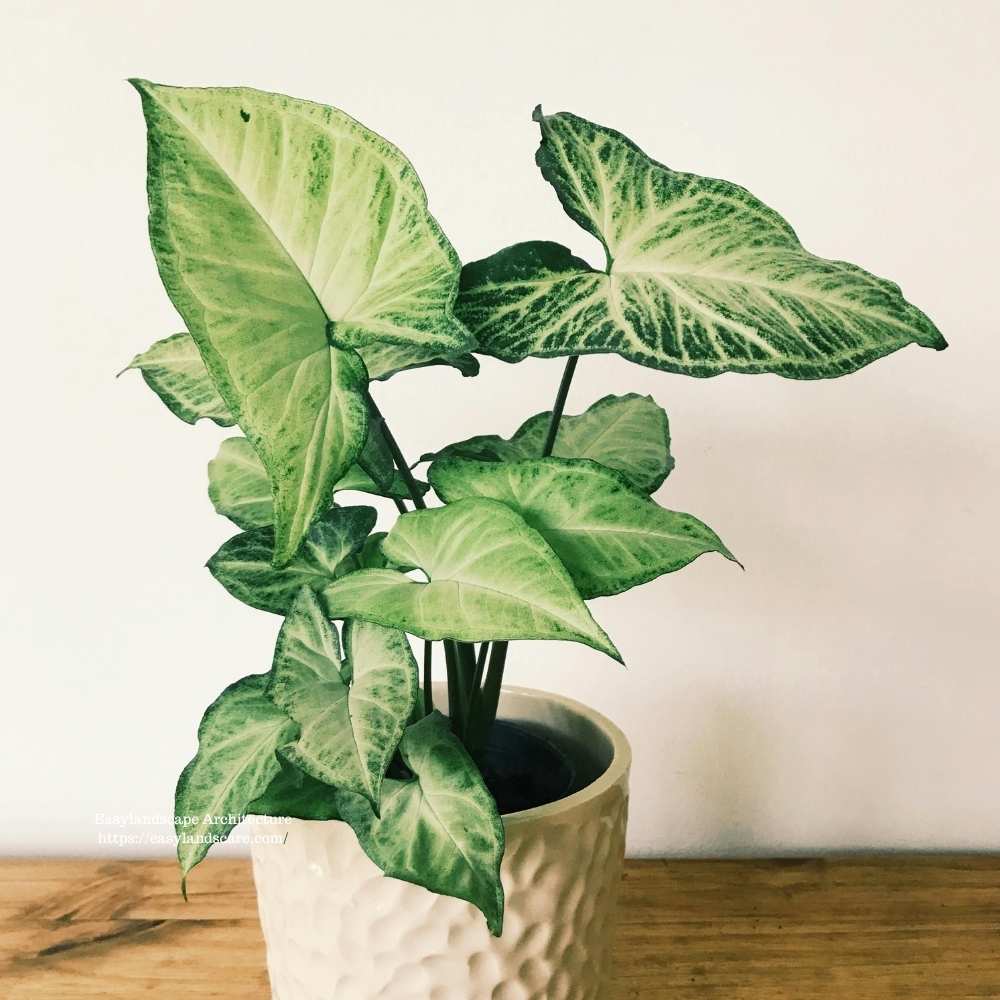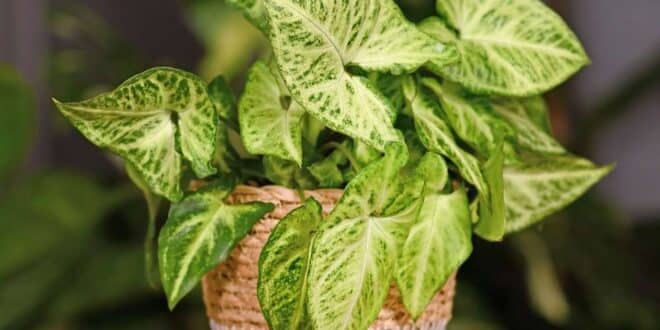Arrowhead Plant
Imagine a plant with beautiful, arrow-shaped leaves that can trail gracefully, climb happily, or even grow into a lush bush, all while being incredibly easy to care for! That’s the charming Arrowhead Plant (Syngonium podophyllum). This delightful green friend is a favorite among plant lovers, and it’s easy to see why – it’s super adaptable and brings a wonderful touch of vibrant greenery to any corner of your home.
From the hot, humid rainforests Central and South America comes the Syngonium podophyllum, loved for its constantly changing foliage and its ability to grow pretty much anywhere. Ready to add this versatile and beautiful plant to your collection? Let’s uncover all the secrets to making your Arrowhead Plant truly flourish!
What Makes an Arrowhead Plant So Unique? Its Shape-Shifting Leaves and Trailing Habits

When you look at an Arrowhead Plant, its most distinctive feature is right there in its name: those beautiful, arrow-shaped leaves! When they’re young, they’re typically heart-shaped, but as they mature, they really do develop that clear arrowhead form, sometimes even splitting into multi-lobed shapes on older plants.
The leaves come in a stunning array of colors beyond just green – think vibrant greens, deep burgundies, soft pinks, creamy whites, and even unique variegations. They have a lovely matte or slightly glossy texture. The Syngonium podophyllum also grows in a wonderfully versatile way: its vines can happily trail from a hanging basket, elegantly climb up a moss pole, or even be pruned to stay as a compact, bushy plant.
Where Do Arrowhead Plants Come From? Central & South America’s Rainforests
Your Arrowhead Plant’s ancestors come from the steamy, warm rainforests of Central and South America, especially in places like Mexico, Costa Rica, and Brazil. In their natural habitat, they often grow on the forest floor as young plants, then use their aerial roots to climb up tree trunks as they mature, reaching for more light. This background tells us why they love warmth, humidity, and filtered light in our homes!
What Are Its Other Names? “Arrowhead Vine” and Its Adaptability
The most common nickname for Syngonium podophyllum is simply “Arrowhead Vine” or “Arrowhead Philodendron” (though it’s not a true Philodendron!). Its names perfectly capture its unique leaf shape and its vining growth habit. Its enduring appeal lies in how incredibly adaptable it is – it can grow in so many different ways and spots in your home!
What Kinds of Arrowhead Plants Are There?
The world of Arrowhead Plants is surprisingly diverse, offering a fantastic range of leaf colors and patterns beyond just green!
Popular Arrowhead Plant Types: A Kaleidoscope of Greens and Pinks
All though Syngonium podophyllum is the main species there are many beautiful hybrids that have been developed. Here are some favorites:
| Type of Arrowhead Plant | Key Features & Colors | Looks Like… |
| ‘Neon Robusta’ | Stunning vibrant pink leaves, sometimes with touches of green. | A bright, cheerful pink splash in your plant collection! |
| ‘Pink Splash’ | Green leaves heavily speckled and splashed with rosy pink. | Like a living watercolor painting. |
| ‘White Butterfly’ | Classic green leaves with a prominent creamy white center, resembling a butterfly. | Elegant and airy with a striking contrast. |
| ‘Maria Allusion’ | Dark green leaves with beautiful bronze, copper, or reddish veins and undertones. | Rich, earthy tones that bring warmth. |
| ‘Emerald Gem’ / ‘Green’ | The traditional, lush solid green arrowhead leaves. Very hardy. | Classic, vibrant green, very reliable. |
| ‘Pixie’ | A compact, dwarf variety with smaller green leaves. Great for small spaces. | A tiny, adorable version of the classic! |
💡 Great spot for an image! You could add a collage here showing the different vibrant varieties of Arrowhead Plants, especially ‘Neon Robusta’ and ‘Pink Splash’ to highlight their unique colors.
Leaf Looks: Colors, Patterns, and Shapes
The beauty of Arrowhead Plants truly lies in their leaves! As they mature, their shape can evolve from a simple heart to a more pronounced arrowhead, and sometimes even a three- or five-lobed form. But it’s the colors that really dazzle – from various shades of green to deep burgundies, bright pinks, creamy whites, and even patterned combinations. These color variations can appear as splashes, veins, or solid blocks of color.
Growth Habit: Versatile Vines
One of the best things about the Syngonium podophyllum is its versatile growth. It naturally wants to vine and climb, sending out aerial roots to cling to surfaces. This means you can allow its attractive foliage to cascade, you can let it drape itself elegantly down from a shelf, or provide it with a moss pole or trellis to climb to help it thrive and grow taller so that it can produce more substantial and mature leaves. You can also prune it to maintain a bushier, more compact shape.
How Do You Take Care of Your Arrowhead Plant?
Caring for an Syngonium Plant is wonderfully simple, making it a fantastic choice for both beginners and experienced plant parents! They’re quite forgiving, which is always a bonus.
Arrowhead Plant Care Summary
Here’s a brief summary on what your Arrowhead Plant enjoys:
| Care Category | What Your Arrowhead Plant Needs |
| Light | Bright, indirect light (essential for vibrant colors, avoid direct harsh sun) |
| Watering | Keep soil moist; water when the top inch feels dry. Don’t let it dry out completely. |
| Temperature | Warm, 60-80°F (15-27°C); avoid cold drafts. |
| Humidity | Consider pebble tray, humidifier, occasional misting; medium to high |
| Soil | Well-draining, rich potting mix (e.g., standard mix + perlite). |
| Pot | Drainage holes are an absolute must! |
| Feeding | Monthly in spring/summer with watered down balanced liquid fertiliser. |
The Right Light: Bright, Indirect Light is Essential
Your Arrowhead Plant loves bright, indirect light. Imagine the dappled light filtering through trees in a rainforest – that’s their happy place! This kind of light really brings out those vibrant colors and patterns in the leaves. Too much direct sun, especially harsh afternoon sun, can scorch their delicate leaves and make their colors fade. While they can tolerate lower light conditions, they might become a bit leggy and lose some of their beautiful variegation.
Watering Smart: Keep Soil Consistently Moist!
Arrowhead Plants love consistent moisture. Water — Allow the top inch (approximately 2.5 cm) of the soil to dry slightly between watering. The trick is to maintain the soil consistently moist, but never soggy! They really dislike letting their roots sit in standing water, which can lead to root rot. Make sure your pot has fantastic drainage! You can ease up on watering a bit during the cooler, slower winter months.
Cozy Temperatures and Humidity, Please!
Although they thrive in the tropics, Arrowhead Plants like it to be warm and grow best in temperatures of 60-80°F (15-27°C). They’re not fans of cold drafts or sudden temperature drops, so keep them in a snug spot! They also appreciate moderate to high humidity. If the air inside your home tends to be arid, particularly during the winter months when heating is on, you may observe some crunchy leaf edges. To create a more hospitable environment, think about utilizing a humidifier, positioning the pot on a tray filled with pebbles and water, or treating them to an occasional spritz of mist.
Choosing the Right Soil and Pot: Drainage is a Must!
To ensure optimal growth, your Arrowhead Plant prefers a potting mix that is both nutrient-rich and has excellent drainage properties. A good quality indoor potting mix works great, and you can add a bit of perlite or orchid bark to make it even airier. In line with the needs of most plants, it’s essential to select a container that features holes for excess water to escape. Syngonium Plants grow pretty quickly, so you might need to repot them every year or two, typically in the spring, into a pot just one size larger.
Feeding Your Arrowhead Plant: Regular Meals During Growing Season
To support the lush foliage development, your Arrowhead Plant will benefit from consistent nourishment during its peak growth periods (spring and summer). Apply a balanced, water-soluble houseplant fertilizer at half the recommended strength, approximately every 4-6 weeks. As the seasons transition to autumn and winter, you can cease fertilization altogether.
What Are Common Problems with Arrowhead Plants and How to Fix Them?
Syngonium Plants are generally resilient, but they’re pretty good at showing you if something’s not quite right. Here’s what to look for:
Common Arrowhead Plant Problems & Solutions
| Problem | What It Looks Like | Common Cause(s) | How to Fix |
| Yellowing Leaves | Lower leaves tend to develop a yellowish tint | Excessive moisture (the most prevalent cause), waterlogged soil conditions | Allow the soil to dry slightly between waterings; verify that the pot has adequate drainage holes to prevent waterlogging. |
| Brown/Crispy Edges/Tips | Dry, brittle leaf edges/tips | Underwatering, low humidity | Water consistently; increase humidity. |
| Leggy Growth/Small Leaves | Long stems, leaves far apart, tiny leaves | Not enough light | Move to brighter indirect light; prune to encourage bushiness. |
| Drooping Leaves | Leaves look limp/sad | Underwatering (thirsty) OR overwatering (root rot) | Check soil moisture: if dry, water; if soggy, let dry/check roots. |
| Fading Colors/Patterns | Foliage displays less pronounced variegation, with a predominantly green hue | Insufficient exposure to intense, direct light | Move to a spot with more bright, indirect light. |
| Pests | Tiny webs, sticky residue, small bugs | General plant stress, dry conditions | Inspect regularly. Treat with insecticidal soap or neem oil. |
| Root Rot | Mushy stems at soil line, foul smell | Persistent overwatering | Prevent with proper watering & drainage. If severe, repot, trim rotten roots. |
Is the Arrowhead Plant Toxic? Safety for Pets
Yes, it’s very important to know: Arrowhead Plants are considered toxic if ingested. Similar to numerous other well-known indoor plants, they possess tiny crystalline structures known as calcium oxalate crystals.
In the event that your feline, canine, or other furry friends ingest or nibble on an Arrowhead Plant, the calcium oxalate crystals can trigger discomfort. Possible symptoms may include:
- Mouth pain and irritation: They may exhibit signs of distress, such as pawing at their mouth, excessive drooling, or displaying discomfort.
- Vomiting: This response is typically observed following consumption.
- Trouble swallowing: As a result of inflammation and discomfort in the oral cavity and throat area.
Although typically not fatal, the experience can be quite distressing for your pets. Therefore, it is strongly advised to position Arrowhead Plants in a secure location, inaccessible to inquisitive pets and young children. Consider placing them in elevated baskets or on high shelves. If you suspect that your pet has ingested any portion of a Syngonium Plant and is exhibiting symptoms, please seek immediate guidance from your veterinarian.
Arrowhead Plant for Home Decor: Versatility and Lush Greenery

The Syngonium podophyllum is an absolute gem for home decor, thanks to its versatile growth and beautiful foliage. It truly fits almost anywhere!
Perfect for Hanging Baskets and High Shelves
With its lovely vining habit, the Syngonium podophyllum is fantastic for hanging baskets or perching on high shelves. Its elegant vines with their changing leaves create a beautiful cascading effect that adds depth and life to your room.
💡 Great spot for an image! You could add a photo here of an Arrowhead Plant beautifully trailing from a hanging basket.
Adding Greenery to Any Corner, Even Dim Ones
Because it’s so adaptable to different light levels, you can pretty much put an Arrowhead Plant in any spot that needs a splash of green! It’s fantastic for bringing life to those trickier corners that don’t get a ton of direct sun.
Great for Styling and Creating Green Walls
Beyond just trailing, you can also train Arrowhead Plant vines to climb up moss poles, trellises, or even artfully arrange them along a wall using small plant clips. This is a fantastic method to incorporate vertical visual appeal and design your very own living green space!
💡 Great spot for an image! A photo here showing an Arrowhead Plant climbing a moss pole or trained on a wall would be perfect!
The Allure of Arrowhead Plants: Easy-Going, Beautiful, and Beneficial

The Arrowhead Plant truly stands out as a wonderfully flexible and rewarding houseplant. It offers an unbeatable blend of effortless care, stunning beauty (especially with those changing leaf shapes and colors!), and incredible versatility in how you can display it. Whether you’re a hectic homeowner, an aspiring plant parent, or merely seeking a trustworthy and stunning green friend, the Syngonium podophyllum is an ideal selection. It’s a reminder that sometimes the most beautiful things are also the easiest to love and adapt to your unique style!
Frequently Asked Questions (FAQ) About Arrowhead Plants
Still have some questions about your wonderful Arrowhead Plant? Here are some common ones that might help you out!
Q1: How often should I water my Arrowhead Plant?
A1: Water your Arrowhead Plant when the top inch (about 2.5 cm) of soil feels slightly dry to the touch. They thrive in consistently moist conditions, but detest waterlogged roots! Ensure your pot has superior drainage to prevent root rot. As a general rule, you’ll need to water more frequently during the warmer seasons and less frequently during the colder winter months.
Q2: Why are my Arrowhead Plant leaves turning yellow?
A2: Yellowing leaves are often a symptom of overwatering. If the soil remains excessively moist, the roots are unable to receive sufficient air and will begin to decay. Ensure the soil is drying out slightly between waterings. It may also be an indication of inadequate light.
Q3: Can an Arrowhead Plant live in low light?
A3: Arrowhead Plants are very adaptable to low light conditions, meaning they won’t die. However, if you have a variegated variety (featuring white or pink hues), it may forfeit some of its attractive patterns and become greener in extremely low light conditions. For optimal growth and coloration, bright, indirect light is the most suitable choice.
Q4: How do I make my Arrowhead Plant look fuller?
A4: To achieve a fuller plant, you can prune it regularly! Simply trim off the ends of the longest vines immediately after a leaf node. This encourages the plant to branch out and produce more shoots from the base, resulting in a much denser appearance. You can even propagate these cuttings to create new plants!
Q5: Why are my Arrowhead Plant’s leaves small and sparse?
A5: Small, sparse leaves that are far apart on long vines usually mean your Arrowhead Plant isn’t getting enough light. It’s stretching to find brightness!
- The Fix: Relocate it to a spot with brighter, indirect light. You can also trim back the leggy sections to promote new, healthier growth.
Q6: Is the Arrowhead Plant safe for my pets?
A6: No, the Arrowhead Plant is considered toxic if ingested by cats, dogs, and other pets. It contains calcium oxalate crystals, which can cause irritation. It’s recommended to keep them in an inaccessible location.
Q7: How fast does an Arrowhead Plant grow?
A7: Arrowhead Plants are generally moderate to fast growers, especially during their active growing season (spring and summer). With sufficient light and proper care, their vines can extend quite rapidly.
Q8: What kind of soil is best for an Arrowhead Plant?
A8: Arrowhead Plants love a well-draining, rich potting mix. A standard indoor potting mix with some added perlite or orchid bark for extra aeration works wonderfully.
Q9: Can I grow an Arrowhead Plant as a climbing plant?
A9: Yes, absolutely! Arrowhead Plants are natural climbers in the wild. You can provide a moss pole, coir pole, or trellis for them to climb on. This encourages them to produce larger, more mature leaves as they grow upwards.





